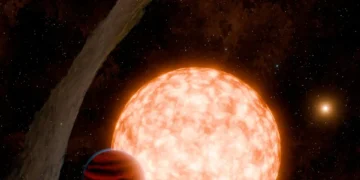A newly discovered planet, IRAS 04125+2902 b, is capturing the attention of scientists for being a cosmic infant—just 3 million years old. This discovery, nestled in the Taurus Molecular Cloud, not only opens a window into the early stages of planetary formation but also challenges existing notions about how young planets can be observed.
A Planet Beyond the Ordinary: The Discovery of IRAS 04125+2902 b
IRAS 04125+2902 b, located approximately 430 light-years away in the Taurus Molecular Cloud, is not your typical exoplanet. At just 3 million years old, this planet is considered a newborn by astronomical standards. What sets it apart, however, is the rare opportunity to observe such a young planet directly—a feat made possible by an unusual warping of its surrounding debris disk. Using NASA’s Transiting Exoplanet Survey Satellite (TESS), researchers detected this young world through the “transit method,” which involves observing dips in starlight as a planet crosses its host star.
Typically, young planets remain hidden behind thick, dusty disks that obscure their visibility. In the case of IRAS 04125+2902 b, a warped outer debris disk allowed scientists to bypass this challenge, offering a rare and clear view of the planet. This discovery highlights the role of chance in astronomical observations. The warped disk, likely caused by dynamic processes within the star system, made IRAS 04125+2902 b accessible to telescopes. Without this unique alignment, the planet would have remained hidden, emphasizing how even minor cosmic irregularities can lead to groundbreaking discoveries.
What Makes IRAS 04125+2902 b Unique?
IRAS 04125+2902 b is not just young—it’s massive, with a diameter comparable to Jupiter but only one-third of its mass. This low density suggests that the planet has an inflated atmosphere, likely still glowing from the heat of its formation. Such characteristics are typical of young planets that have not yet stabilized, and over time, its atmosphere may shrink, potentially transforming it into a mini-Neptune or a rocky super-Earth.
This discovery offers invaluable insights into planetary evolution. By studying IRAS 04125+2902 b, astronomers can better understand how planets transition from their chaotic early stages to more stable forms. The findings also shed light on the diversity of exoplanets, highlighting how young planets differ significantly from their mature counterparts. Moreover, the planet’s proximity to Earth in astronomical terms—just 430 light-years—makes it an ideal candidate for further study.
The Mystery of the Warped Disk
One of the most intriguing aspects of IRAS 04125+2902 b’s discovery is the warped outer disk surrounding its host star. This distortion is both a mystery and a key factor in the planet’s visibility.
- Planetary Migration: One possibility is that IRAS 04125+2902 b itself migrated closer to its host star, disrupting the alignment of the debris disk. Such a scenario would require the presence of another massive object within the system to generate the gravitational forces needed for such a shift. However, no such object has been detected so far.
- Companion Star Influence: The system’s host star has a distant stellar companion, which could be responsible for the disk’s misalignment. The gravitational pull of this companion star may have caused the outer disk to warp while leaving the planet’s orbit edge-on from Earth’s perspective.
- Gravitational Interactions: Another explanation involves the dense and chaotic environment of the Taurus Molecular Cloud. In such a star-forming region, infalling material could exert gravitational forces on the disk, creating the observed distortion. This theory aligns with computer simulations but remains unconfirmed.
Combining Techniques: The Power of Observation
The discovery of IRAS 04125+2902 b underscores the importance of combining observational techniques in astronomy. While TESS’s transit method provided initial insights, radial velocity measurements added a new layer of understanding. By detecting the gravitational wobble caused by the planet’s orbit, scientists were able to estimate its mass and infer details about its composition.
This synergy between observation methods is a testament to the advancements in exoplanet research. It demonstrates how modern technology allows scientists to overcome challenges, such as observing young planets in dense, dusty environments.
The Broader Implications: What This Discovery Teaches Us
The discovery of IRAS 04125+2902 b has far-reaching implications for planetary science. First, it provides a rare glimpse into the early stages of planet formation, offering clues about how planets develop and evolve. By studying this young world, astronomers can refine existing models of planetary systems, bridging the gap between theoretical predictions and observational data. Second, the discovery highlights the diversity of exoplanets in the galaxy.
The possibility that IRAS 04125+2902 b could evolve into a mini-Neptune or super-Earth underscores the dynamic nature of planetary evolution. It also raises questions about the prevalence of such planets in the universe and their potential to host life. Finally, the discovery emphasizes the need for continued exploration of star-forming regions like the Taurus Molecular Cloud.
Conclusion: A Window Into the Cosmos
The discovery of IRAS 04125+2902 b is a testament to the power of curiosity and the ingenuity of modern science. By uncovering a young planet hidden in the depths of the Taurus Molecular Cloud, astronomers have opened a window into the early stages of planetary formation. This discovery not only advances our understanding of young planets but also inspires new questions about the processes that shape the universe.
Reference:
A giant planet transiting a 3 Myr protostar with a misaligned disk



















